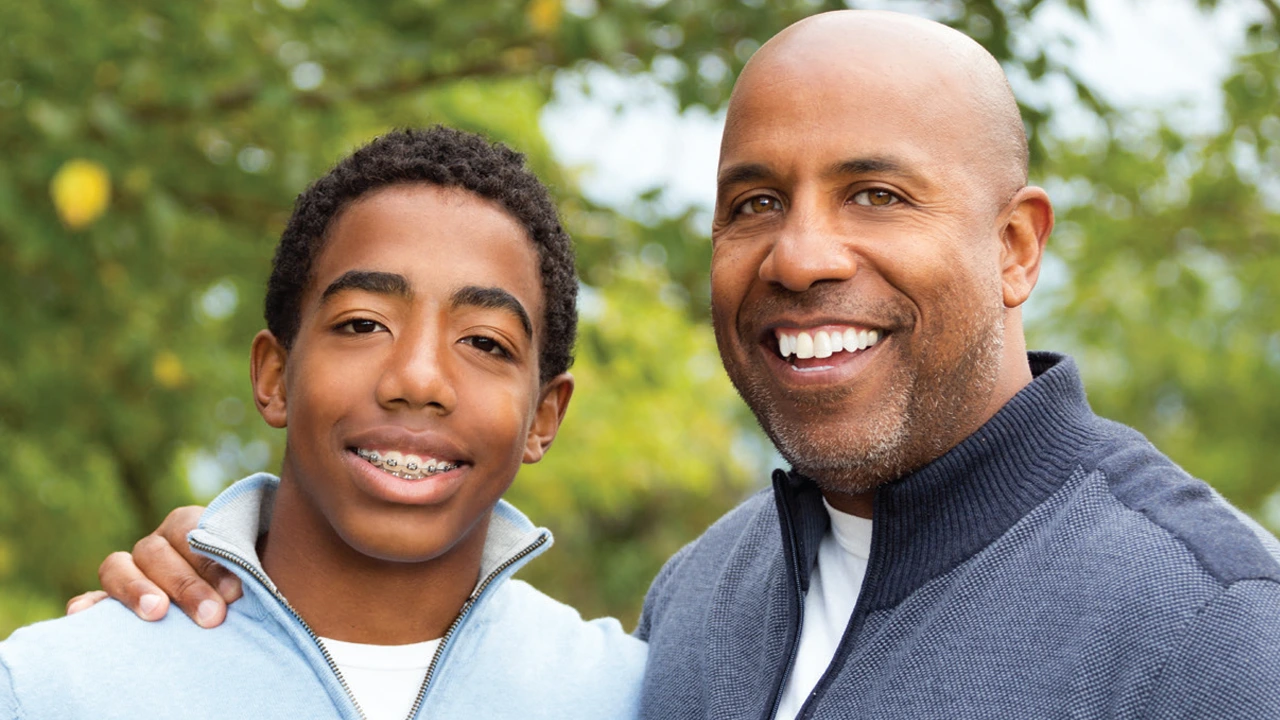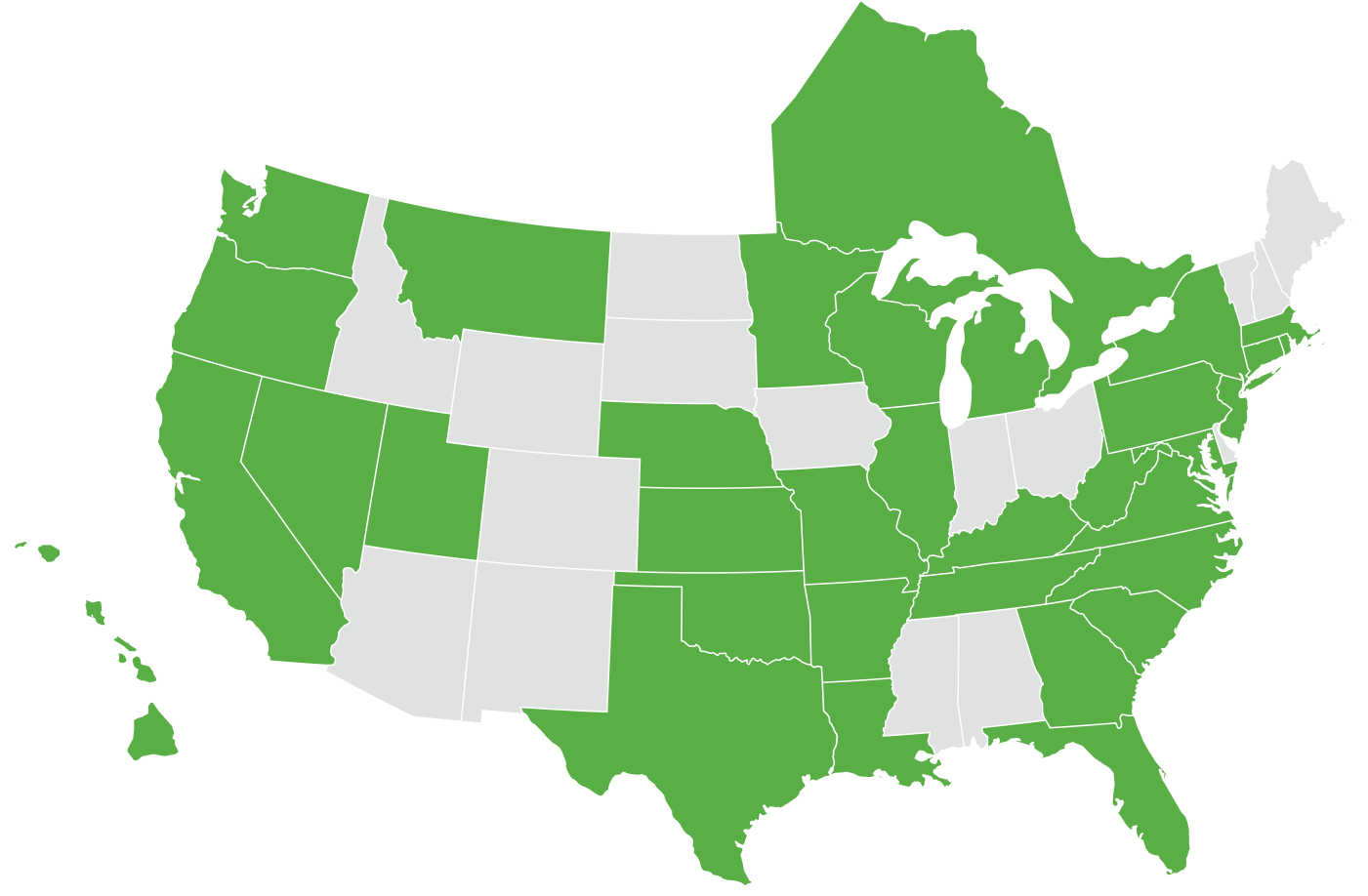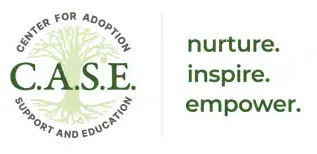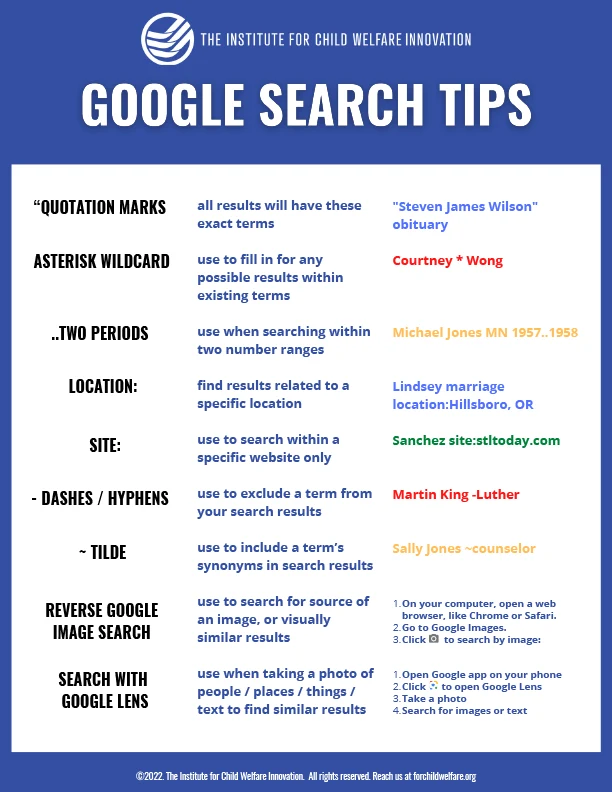
The Institute for Child Welfare Innovation (the Institute) is a program of the Foster & Adoptive Care Coalition that offers training and replication services for child welfare professionals across the country. Since inception, the Institute has trained more than 6,250 professionals in family finding throughout 35 U.S. states and parts of Canada. Join us as we challenge the status quo in child welfare.
Training & Coaching Services
We strive to provide information that will equip professionals with essential knowledge and skills to actively support and empower them to create a brighter future for children and families.

Program Replication: 30 Days to Family®
- 30 Days to Family® is a nationally recognized and evidence-informed model created by the Coalition which has been rated both by the California Clearinghouse for Evidence-Based-Practices and the federal Title IV-E Prevention Services Clearinghouse.
- For a fee, any child welfare agency can replicate the evidence-based 30 Days to Family® Program, as a multi-year, stage-based implementation project. Our process is highly refined, with proactive fidelity monitoring.
Diligent Search
We locate and re-engage relatives of children impacted by foster care so that children are placed where they truly belong—with their families.
Where We Work

Arkansas (AR)
California (CA)
Connecticut (CT)
Florida (FL)
Georgia (GA)
Hawaii (HI)
Illinois (IL)
Kansas (KS)
Kentucky (KY)
Louisiana (LA)
Maryland (MD)
Massachusetts (MA)
Michigan (MI)
Minnesota (MN)
Missouri (MO)
Montana (MT)
Nebraska (NE)
Nevada (NV)
New Jersey (NJ)
New York (NY)
North Carolina (NC)
Oklahoma (OK)
Oregon (OR)
Pennsylvania (PA)
Rhode Island (RI)
South Carolina (SC)
Tennessee (TN)
Texas (TX)
Utah (UT)
Virginia (VA)
Washington (WA)
Washington, D.C. (DC)
West Virginia (WV)
Wisconsin (WI)
Ontario (ON), Canada
Resource Library
Explore a curated set of tools and resources to support professionals in locating family, engaging with youth, and fostering stable, successful family connections.
Explore our list of helpful family-finding websites below. Have a favorite resource we missed? Share it with us!
Individual Locator Search Databases
Connect Our Kids (free account sign up required)
Whitepages (limited info for free)
Social Media Sites for Searching
X (formerly Twitter)
Myspace (some people forget they had this site and everything is open to view)
Historical Records
FamilySearch (free account, sign up required)
Offender/Inmate Information
Federal Bureau of Prisons Inmate Locator
National Sex Offender Registry Search
US Immigration and Custom Enforcement detainee database
Interstate Compact Offender Tracking System
Many searches happen through state and local databases or websites. While we don’t have direct links, don’t overlook these valuable resources:
- State Business Registrations
- State Professional Registrations
- County Real Estate and Personal Property Records
- State Department of Corrections
- State/County Court Records (civil, criminal, probate, traffic)
- State/County Warrant Search Databases
- Local Library Searches (genealogical information and obituary information)
- Local Newspaper searches (obits/news stories)
Engagement Scripts
Primer scripts for engaging with family members of children in care.
Engagement of Fathers and Paternal Family Members
Research shows father and paternal kin engagement improves outcomes for children, yet agencies often face challenges in making these connections. The tools below offer strategies and evidence-based practices to help you engage fathers and paternal family members more effectively and support family well-being.
Family Engagement: Partnering with Families to Improve Child Welfare Outcomes
A publication from the Children’s Bureau, July 2021. This is a great resource for overcoming barriers to family engagement.
Protective Factors Conversation Guides
Protective Factors Conversation Guides were created to help service providers engage caregivers in personalized conversations about the protective factors. Each set (one for each of the six protective factors) includes a guide for service providers and a worksheet for caregivers.
Engaging with Youth in Foster Care
A quick reference, 2-pager that anyone working in the child welfare space will be able to easily reference while they are meeting with a young person. This tool includes primers for conversations, pointed questions to ask, and tips & tricks phrases or things to avoid.
Engagement Tips with Youth
Created during our Family Search & Engagement Learning Collaborative.
Engagement with Family
Created during our Family Search & Engagement Learning Collaborative.
Durham County Counsel Engaging Families Toolkit
Provides practitioners and managers with guidance to assist the effective engagement of families in the offer of support across all levels of intervention from early help and targeted services through to statutory services. From the Durham County Counsel.
“Engage Us”: A guide written by families for residential providers
The Building Bridges Family Advisory Network developed this guide as a tool to support providers in their efforts to improve the experience and outcomes for children and families. The goal of this guide is to deepen family-driven practice and promote better engagement with families.
Questions for Finding Naturally Connected Networks
Building natural support networks for parents, youth, and children—thanks to Andrew Turnell and Sarah Brandt for creating and sharing these resources.
“7 Tips” Info Sheets on Supporting LGBTQIA+ Youth
Access two quick fact sheets from the Children’s Bureau on supporting LGBTQIA+ youth as a caregiver.
Advancing Equity and Inclusion Through the Child and Family Service Reviews
A report on how federal Child and Family Service Reviews are advancing equity in services
The Child and Family Services Reviews (CFSRs) are designed to determine states’ compliance with titles IV-B and IV-E of the Social Security Act, and to evaluate child welfare system performance and require states to make improvement in outcomes for children and families. To create a system that is effective and equitable for all, we must pay particular attention to the experiences of those who may be marginalized and more likely to have disparate outcomes.
Child Welfare Practice to Address Racial Disproportionality and Disparity
From the Children’s Bureau’s “Bulletins for Professionals” Series- April, 2021
This bulletin provides a brief overview on the issue of racial disproportionality and disparity in the child welfare system and the factors that contribute to the problem. It then describes practices that child welfare caseworkers, administrators, program managers, and policymakers can implement to address these issues in general and at specific decision-making points along the child welfare continuum.
Counsel for Kids Promoting Race Equity
Black and Indigenous children are overrepresented in the child welfare system relative to their representation in the general population. High-quality legal representation can help confront and challenge racism in individual cases and is a key strategy for addressing systemic racial disproportionality and disparity.
Amplify the Child’s Voice!
Download this PDF reviewing the ways Counsel for Kids is promoting racial justice by providing representation.
Cultural Responsiveness
From the Child Welfare Information Gateway
Cultural responsiveness enables individuals and organizations to respond respectfully and effectively to people of all cultures, languages, classes, races, ethnic backgrounds, disabilities, religions, genders, sexual orientations, and other diversity factors in a manner that recognizes, affirms, and values their worth. Being culturally responsive requires having the ability to understand cultural differences, recognize potential biases, and look beyond differences to work productively with children, families, and communities whose cultural contexts are different from one’s own. In this section you will find resources that describe the elements of being culturally responsive.
Focusing on Race Equity Throughout Change and Implementation
Addressing racial and ethnic disparities in child welfare requires agencies to intentionally focus on equity, including while planning for change and implementing new programs and practices.
Achieving equitable services and outcomes demands deliberate use of race equity and inclusion principles from the earliest stages of exploring a problem to identifying its causes and solutions to ensuring sustainable implementation.
This tip sheet includes questions for teams to consider throughout change and implementation processes. Child welfare leaders, implementation team members, and technical assistance providers can use the discussion questions to raise awareness, promote reflection, and encourage actions that center equity as a goal within any implementation effort.
LGBTQIA2S+ Resources
The National Quality Improvement Center on Tailored Services, Placement Stability, and Permanency for Lesbian, Gay, Bisexual, Transgender, Questioning, and Two-Spirit Children and Youth in Foster Care (QIC- LGBTQ2S) was a 5-year grant established in collaboration with the Children’s Bureau to develop, integrate, and sustain best practices and programs that improve outcomes for children and youth in foster care with diverse sexual orientations, gender identities, and gender expressions (SOGIE).
This page presents resources developed by the QIC-LGBTQ2S in partnership with people with lived experience who helped implement the work of the QIC within their local implementation sites.
Parenting in Racially and Culturally Diverse Adoptive Families
From the Children’s Bureau’s “Factsheets for Families” series- Sept. 2020.
This factsheet provides information to help you and your family support your child in developing a healthy racial and cultural identity and live a vibrant multicultural life. It discusses the importance of examining your thoughts and biases and preparing your child to live in a society where race has a major impact on individual lives. You can use this factsheet as a resource for information on some of the potential rewards and challenges that come with choosing to live a multicultural and multiracial family life.
Race Equity Hub—NACC
From the National Association of Counsel for Children.
The child welfare system often perpetuates racism, bias, poverty, and the trauma of family separation against children and families of color. NACC encourages advocates and practitioners to resist these injustices by demonstrating cultural humility, pursuing antiracist practices, confronting personal privilege and bias, utilizing a race equity lens when making decisions, and promoting diversity and inclusion. This hub includes resources that support race equity, one of NACC’s core values. NACC will update this hub on a regular basis.
Email christina.lewis@NACCchildlaw.org to share additional resources for posting on this hub.
Button: Visit the NACC Race Equity Hub
Racial Equity Resources for Child Welfare Systems
From the Child Welfare Information Gateway.
Historically, the child welfare system has struggled with achieving equity for all identity groups. There are myriad issues that contribute to the disproportionate adversity experienced by families of color. Additionally, children and youth from diverse populations are overrepresented in the system and may receive less consistent services. This disproportionality often results in unequal outcomes.
It is therefore essential to address these issues at the individual and systems levels. Black, Brown, and Native children cannot be supported without simultaneously strengthening and caring for Black, Brown, and Native families. This includes systems investing in prevention services and wraparound services for struggling parents as well as antiracism training for child welfare professionals. Antiracism is defined by the active opposition of racist ideology and the promotion of racial tolerance. Below, find resources about implementing antiracism practices and working with diverse populations at the systems level.
SOGIE Center: Promoting the Wellbeing of LGBTQ+ Youth and their Families
The National SOGIE Center has compiled a database of resources on serving LGBTQ+ youth and families in systems. This database is being continuously updated. Please send any resources you’d like us to include to SOGIEcenter@ssw.umaryland.edu.
Threading Equity Throughout Child Welfare: Podcast
This episode of the Child Welfare Information Gateway Podcast features a conversation with Aysha E. Schomburg, J.D., associate commissioner, Children’s Bureau, Administration for Children and Families, U.S. Department of Health and Human Services.
This conversation dives into each priority goal, including any Federal policy or guidance updates and recommendations, along with how these actions connect and relate to the work performed by frontline child welfare professionals.
Understanding the Past to Build a New Future: Advancing Racial Equity for Children, Youth, and Families
Information from this presentation can help participants expand their awareness of how and why racial and ethnic disparities exist in child welfare systems and in outcomes for children, youth, and families. Presenters explore some of the history that has created the modern-day U.S. child welfare system and examine how racial and ethnic disparities currently show up in this system. They also share examples and strategies for advancing racial equity, including meaningfully sharing power and decision-making with youth and families to build more equitable and responsive child welfare systems.
From the Capacity Building Center for States- 2021
Working with African-American Families
A resource list from the Child Welfare Information Gateway.
This page highlights issues relevant to working with African-American families. This includes understanding the impact of historical trauma and ongoing trauma on African-American individuals and families as well as relevant cultural issues. Below, find resources to support child welfare professionals in working with African American children, youth, and families, including state and local examples.
Working with LGBTQ+ Families in Foster Care and Adoption
From the Children’s Bureau’s “Bulletins for Professionals” Series- June, 2021.
This bulletin is designed to help child welfare and adoption professionals expand their cultural competence and skills when working with parents who identify as lesbian, gay, bisexual, transgender, questioning, and other diverse identities and expressions, including Two-Spirit (LGBTQ+) and same-gender or gender-diverse couples.
Working with LGBTQ+ Youth and Families
From the Child Welfare Information Gateway.
Adolescence is marked by rapid physical development and emotional changes while youth work to develop autonomy and a sense of identity. This period is further complicated by child welfare involvement, which is often associated with changes in social support and placement. Youth who identify as lesbian, gay, bisexual, transgender, questioning, or another diverse identity (LGBTQ+) are overrepresented in the child welfare system and face several additional complex challenges beyond those typically associated with adolescence, including discrimination and threats to their physical and emotional wellbeing.
It is therefore extremely important to understand how to strengthen protective factors and effectively work with this population. Resources on this page support child welfare workers serving this population, while subpages include resources for LGBTQ+ youth in out-of-home care and resources offering support and guidance for LGBTQ+ youth and their families.
Circles of Support
What are Circles of Support?
Circles of Support, also known as Relationship Circles or Circles of Friends, are the most critical element to the sustainability of a person-centered plan.
The Circle of Intimacy are the people who are closest to you, those we rely on every day and those who know us best. They are people we can hardly imagine living without. Examples include parents, grandparents or other family, housemates, caregivers.
The Circle of Participation are our friends and family members who know us well, who we can call on when we need them and who can call on us. Examples are friends at school or work, team mates or coaches, people where you worship, support staff, teachers.
The Circle of Participation are those who we might see with regularity, who have some interests or associations in common with you. Examples are people at the gym, team mates or coaches, bus drivers, neighbors, people where you worship, customers where you work.
The Circle of Exchange includes people who are in your life because they are providing a service you are paying for. We all have people who fit into this category; doctors, therapists, trainers, support providers, hair dressers, attorneys.
Click the button below for a printable Circles of Support template you can use immediately.
Ecomapping
The Ecomap was developed by Dr. Ann Hartman. It was designed as a visual diagram that shows how someone relates to others. The connections between the individual and their formal/informal connections can be positive or negative but is discussed in a strength-based approach.
How to Create an Ecomap:
- Obtain a sheet of blank paper and a pencil to begin the process
- Draw the person in a large circle
- Smaller circles are drawn around the client’s circle to represent people, groups, etc. that they have a relationship with.
- Draw the type of connections between the client and each connection in smaller circles
- Make sure to draw a definition of each Ecomap legend
- Arrowheads should be used at the end of each line to indicate the direction in which resources flow or the level of mutuality of the relationship
- Make sure to include a date
- This is just a starting point of a discussion
What Questions to Ask:
- “Who is important to your life?”
- “Who do you spend most time with?”
- “What groups, activities or memberships do you hold or belong to?”
- “Who do you talk to in your neighborhood? “
- “Is anyone missing?”
Below is a short video regarding Ecomapping:
Genogram
What is a Genogram?
What is a great way to visually link family connections? Genograms. This tool is used to explore someone’s family history in an artistic way. The genogram is similar to a family tree but obtains more information regarding relationships and connection. This family engagement tool can display three, four or as many generations as you would like along with their relationships to each other. Displayed on the genogram includes various identifying information such as names of relatives/kin, date of birth and date of death.
Pro tip: Genograming is an art and gets easier with practice. Try making a genogram for your own family first. It may help you think through what questions to ask, what information is interesting and what information may be missing.
Lifebooks
A lifebook is a collection of a child’s memories, important items and mementos, photos, drawings, journals, and anything else that is important to the child. A lifebook brings together a child’s past, present, and future. It’s purpose is to document a child’s history, celebrate accomplishments, and allow his or her talents to shine. It is a record of a child’s life in his or her own words.
Lifebooks can be preserved in a binder, photo album, or scrapbook, but can also be collected digitally, as a box of trinkets or in many other creative ways. The possibilities are endless!
While it’s best to start a lifebook when the child is first placed in foster care, it’s never too late to start.
The lifebook belongs to the child. The child decides who can look at it. If the child moves, the lifebook goes with them.
Lifebook Links:
Below are some helpful links that offer more information about lifebooks but also downloadable templates and tools to help get you started!
Life Mapping
What is Life Mapping?
Life Mapping is a technique used to explore key life milestones. It is a wonderful opportunity to creatively share some of life’s successes, obstacles, talents or passions in a sequential way. Artistic skills can shine when engaging with children. It is also a great way to find out what is important to them. Use paper, markers, crayons, pictures or any other medium to explore the lives of children.
Mobility Mapping
How to Mobility Map:
- After establishing a rapport with the child, explain that you would like to learn more about him or her to help trace family and relatives through drawing a picture (map).
- Draw a small house in the middle of the paper. Explain that this represents his or her house. Now ask the child to draw all the places around the house that he or she used to go to.
- After you have verified that the child understands the exercise, allow him or her time to draw without interruption. Be patient and encouraging.
- Once the child finishes, label each place on the map. Ask the child to label any places added to the map.
- Then ask the child to mark all the places that he or she liked best with a particular color of pencil or sticker.
- Interview the child regarding their most liked places first.
Questions to Ask:
- “Tell me about this place. Why do you like it?”
- “Who did you visit there?”
- “What is your favorite memory of this place?”
Below is a short video regarding Mobility Mapping
Permanency Pact
A Permanency Pact is a pledge by a supportive adult to provide specific supports to a young person in foster care with a goal of establishing a lifelong, kin-like relationship. Youth transitioning from foster care are often unsure about who they can count on for ongoing support. Huge thanks to FosterClub for developing this resource.
Prediction Narrative
This tool was developed by the Foster & Adoptive Care Coalition’s Extreme Recruitment program, adopted from the works of Kay Donley Zeigler.
This tool is used to predict a youth’s potential needs and behaviors to better equip a caregiver to meet those needs.
Roadmap to Family
Here you’ll find the Roadmap to Family, developed by the Foster & Adoptive Care Coalition. The Roadmap to Family is used in the 30 Days to Family® program to outline a plan for relative support and placement stability.
The 1st section outlines a child’s needs, considerations, and services that must be coordinated in order to meet those needs.
The 2nd section is a straightforward go-to list of everyone who has been identified to support the youth and the caregiver.
The Foster & Adoptive Care Coalition has given permission for you to use the Roadmap to Family as inspiration and a template to adapt for the needs of your families, children, and communities.
Well-Being Indicator Tool for Youth
The WIT-Y is a guided self-assessment tool for youth ages 15-21 that encourages youth to explore their own sense of well-being across eight domains by asking them to rate each domain on a five-point continuum, ranging from “In Crisis” to “Doing Great.” Examples of varying levels of well-being are presented to facilitate this process. At the end of the tool, the youth will be given a graphic representation (called the Well-being Snapshot) of their well-being levels in each domain. The tool is intended to promote discussion between youth and their workers but could be used in a number of other ways.
Anu Family Services contracted with the Center for Advanced Studies in Child Welfare (CASCW) at the University of Minnesota to develop the Well-being Indicator Tool for Youth (WIT-Y).
Below is a link where you can download the WIT-Y User Guide and templates, as well as a downloadable blueprint.
Youth Connections Scale
The Youth Connections Scale (YCS) was developed in order to fill a need in child welfare: To evaluate and measure the increased efforts of agencies to improve the relational permanence of youth in foster care. The YCS was developed by the Center for Advanced Studies in Child Welfare (CASCW) at the University of Minnesota in partnership with Anu Family Services.
Below is a link with more information and downloadable PDFs for the YCS.
American Bar Association Resources
For National Reunification Month in 2022, the ABA put together this amazing hub of resources for all things reunification. Included you’ll find webinars, articles, testimonials from those with lived experience, and actual tools to put into your practice promoting reunification in child welfare.
Birth and Foster Parent Partnership: A Relationship Building and Leadership Guide
The Birth and Foster Parent Partnership (BFPP) was formed in 2016 to support birth parents, foster families, kinship caregivers and staff in improving relationships, building connections and using their collective voices to transform systems, culture, policies and practices to improve outcomes for children and families.
Equipping Foster Parents to Actively Support Reunification
From AdoptUSKids, this document acts as a guide for organizations and child welfare professionals to help them assess their approach to preparing and supporting foster parents in their role in working toward reunification.
Icebreaker Meetings
Developed by the Annie E. Casey Foundation’s Family to Family Initiative Icebreaker meetings are designed to be the first step in building a connection between birth parents and foster parents and preparing them to work together to ease the child’s transition between families.
The main purposes of Icebreakers are to allow the birth and foster parents to share information about the child, such as daily routines, food preferences, favorite toys, and medical needs, and to make preliminary plans for visitation. The child is usually included in the meeting so that he or she can also share information and ask questions.
Partnering with Parents
Across the country, birth parents, foster parents and child welfare professionals alike are working towards reunification and improving the transition process. Many courts and child welfare agencies are turning to parents who have previous system involvement to provide mentoring and guidance to parents entering the system. Commonly known as parent partner, parent mentor and parent ally programs, this approach has emerged nationwide as a powerful tool for family empowerment and engagement.
Reunifying Families
From the Child Welfare Information Gateway
When children must be removed from their families to ensure their safety, the first goal is to reunite them with their families as soon as possible. Child welfare agencies implement multifaceted strategies that build on family strengths and address concerns. Such strategies may include family engagement, maintaining family and cultural connections, connecting families to evidence-based services in the community, regular and frequent visits among family members and with the worker, and parent education, among others. Returning children home often requires intensive, family-centered services to support a safe and stable family. Services should be tailored to each family’s circumstances and should address the issue(s) that brought the child and family into the child welfare system. The following resources offer an array of practices and strategies that support family reunification efforts in child welfare, including State and local examples.
Supporting Successful Reunifications
This bulletin offers information to help child welfare agency managers by providing strategies for achieving reunification and preventing reentry and includes examples of promising practices being implemented by states and localities.
From the Child Welfare Information Gateway- a Bulletin for Professionals, 2017



